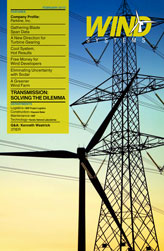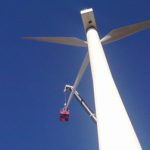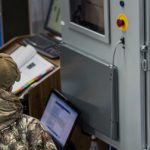According to the Department of Energy (DOE), one of the primary challenges to getting more wind, solar, and other renewable energy projects developed is transmission. Transmission lines are needed to carry energy developed in sparsely populated areas of the Midwest and West to urban areas with higher population and higher energy demands. According to the February, 2009, “Green Power Super Highways” white paper, nearly 300,000 MW of wind generating projects were on hold to connect to the grid. The lack of transmission is not a newly created problem. The current situation is a result of inadequate investment in transmission in the 1990s. Investment during this period dropped to a low of $3 billion per year in 1999 (inflation adjusted). While that number has risen significantly, to $9.5 billion in 2008, development of transmission still lags behind a growing need. The North American Electric Reliability Corporation (NERC) warns investment needs to be increased and accelerated. In October, 2008, NERC projected that generation will grow by 21 percent while transmission miles will only increase by 9.5 percent. Furthermore, it warned, some areas may experience insufficient transmission reliability by 2010.
The causality dilemma of transmission exists because developers hesitate to move forward on generation projects without access to transmission lines, and transmission lines are seldom built without generation facilities with which to hook up. Complicating the preexisting matter has been the recent increase in developing renewable energy projects. Many of these wind and solar projects, prompted by state-legislature passed RPS requirements, lack access to transmission lines to carry power to the demand. Twenty-eight states had enacted RPS standards by the beginning of 2009, and most of these require a specific percentage of electricity used in the state to come from renewable energy. In addition to the facilitative dynamics other hurdles also exist, including policy, who should decide on new transmission, environmental, ecological impact of where transmission lines are to be built, and financial—who will pay for new transmission?
While many states, utilities, and organizations struggle, some have found ways to move forward. Colorado, Texas, and California are all making progress by taking original and innovative approaches to these transmission issues. The following highlights come from a recently published report by the National Renewable Energy Lab detailing these efforts.
The state legislature in Colorado took two important steps in 2007 to overcoming these obstacles. First, it created a task force to recognize Renewable Resource Generation Development Areas (GDAs). These areas would be identified for having high renewable energy generating potential (at least 1,000 MW) but limited current transmission capacity. Similar to the state task force’s GDAs, the legislature passed an additional bill in 2007 requiring utilities in the state to identify their own Renewable Energy Resource Zones (ERZs). Utilities were asked to create transmission plans to tap into these areas, and begin submitting applications for the development of new transmission lines. The utilities are required to conduct this review process every other year. Initially, the state taskforce identified eight wind-resource GDAs (total potential capacity: 96 GW) and two solar-resource GDAs (total potential capacity: 5.5 GW). Xcel Energy identified four ERZs and one transmission line project. The utility’s findings were later expanded taking into account the work of the taskforce. Participating utilities “may recover transmission development costs during construction at the weighted average cost of capital, including a return on equity.” (Schumacher, Fink, and Porter, 6.)
Similar to Colorado, Texas faces the transmission challenge as a result of both RPS regulation and geographic separation between resources and population. The Texas legislature passed an RPS increase in 2005, with a requirement of 5,880 MW of renewable energy by 2015. The bill also set a goal of 10,000 MW of renewable energy by 2025. The geographic challenge in Texas is due to it having some of the greatest instate distance between high renewable resources in the West and high population centers (Dallas, Fort Worth, and Houston) in the east. A third challenge in the state also exists, in that the Panhandle and a portion of Eastern Texas are in different grids than the majority of the state. However, even with such great challenges officials in the state have pushed forward with a number of efforts. In 2005, Competitive Renewable Energy Zones (CREZs), similar to the GDAs and ERZs in Colorado, were developed by the state legislature. By 2007 the Electric Reliability Council of Texas (ERCOT) identified five of these high renewable energy generating CREZ areas in West Texas and the panhandle. ERCOT also produced several different scenarios for new transmission development. The most discussed scenarios were two and three. New transmitted energy ranged from 12,053 MW to 24,859 MW from these CREZ proposals. Cost estimates for the scenarios were published in April, 2008 and ranged from $2.95 billion to $6.38 billion. The Public Utility Commission of Texas (PUCT) granted preliminary approval for the second scenario at an estimated cost of $4.93 billion. The chosen scenario would provide 18,456 MW of wind power transmission (Austin Energy estimated one MW equal power usage of 750 homes, thus producing new renewable energy coverage for 13,842,000 homes). The transmission development includes 2,334 miles of new 345-kV line and 42 miles of new 138-kV lines. To finance this new transmission, costs will be spread across all load-serving entities in ERCOT. The reasoning for this is that when complete, new lines will become a part of the massive Texas-wide power grid. As an example, Austin Energy would be responsible for around $200 million, based on its 4 percent share of the ERCOT power load. Construction will be staggered over time with the first of these projects projected to be complete in 2011 or 2012. According to Paul Sadler, executive director of The Wind Coalition, Texas “has developed a process that will serve as a model for the country as we look to diversify our energy fuel mix.”
California faces a similar dual challenge with one of the most aggressive RPS standards in the country and great distance for transmission to cover. The state’s legislature has passed a requirement of 20 percent renewable energy by 2010, and a goal of 33 percent by 2020. Experts both instate and nationally have recognized that transmission will be a primary obstacle, but this has not prevented at least two concurrent efforts to solve the problem. To overcome the challenges of financing new transmission lines in the state, the Federal Energy Regulatory Commission (FERC) approved an inter-connection tariff in December, 2007. This Location-Constrained Resource Inter-Connection Tariff (LCRI) will allow the California Independent System Operator (CAISO) to recover costs through a transmission access charge assessed to all loads on the grid. Once built, generators will begin paying a proportionate share of transmission costs. Most recently, in May 2009, CAISO announced that the board of governors has approved the first project. The Highwind Project transmission upgrade, which will eventually consist of 10 miles of new lines in addition to a new substation, has an estimated cost of $46 million. This project ranked fourth best in terms of environmental impact—seventh best in terms of economic—and was recognized as having the greatest potential energy output at just over 25,000 GWh per year.
Similar to efforts in Colorado and Texas, the California Public Utility Commission (CPUC), in conjunction with other regulatory agencies, launched the California Renewable Energy Transmission Initiative (RETI) in September, 2007. This effort aims at identifying Competitive Renewable Energy Zones (CREZs) both in-state and in neighboring states that require additional transmission to get online. The California RETI is structured in three phases. First CREZs were identified and ranked based on several factors including economic effectiveness, environmental impact, certainty of development, etc. The six-highest ranked CREZs had a combined in-state energy potential of nearly 75,000 GWh/yr, and out-state energy potential of 15,000 GWh/yr. The out-state CREZs were located in Oregon, Nevada, and Baja California Norte. The second phase of the effort involved further defining and refining conceptual transmission plans. New transmission lines were categorized as “Foundation,” “Delivery,” and “Collector.” Proposed foundation lines increase overall capacity within the California network. Delivery lines would move energy from Foundation lines to major load centers. Finally, Collector lines connect the CREZ-areas to the Foundation and Delivery transmission lines. The total cost of the plan is estimated to be $6.5 billion.
In addition to state-focused efforts, there are also efforts happening between states and state and federal agencies. For example, the Bonneville Power Administration (BPA) is moving towards a new methodology for transmission. Historically, the BPA required power generators to provide all the upfront funding for new market-based transmission. However, the organization is now hosting “open seasons” where generators can submit projects to the BPA during specified time periods for consideration of funding assistance. Through this program the BPA has committed to provide new transmission service if it can be paid for at BPAs embedded cost rate and if BPA can meet the requirements of the National Environmental Policy Act (NEPA). The BPA is also willing to pay for initial engineering and design studies. During the first open season in 2008, 153 transmission requests were submitted by 28 participating BPA customers. Submitted projects represented nearly 6,500 MW. Following the open season submission period, BPA selected five projects enabling connection to 3,360 MW of generation (2,575 MW of which is from wind power). Total costs are estimated to be near $800 million. Construction of the first project, the McNary-John Day 500-kV transmission line that will connect power to Seattle, Washington, and Portland, Oregon, began in spring of 2009. The project, which had previously been approved, but was on hold for lack of financing, is now being partially financed by the American Recovery and Reinvestment Act. When it goes online in 2012 it will provide transmission access for an additional 870 MW of energy (700MW of which is wind power). Recently, BPA held a second open season and received 83 transmissions service requests enabling nearly 5,000 MW of energy (2,599 MW of which were wind power).
In another example of innovative regional transmission strategies, the Southwest Power Pool (SPP)—which includes areas in Kansas, New Mexico, Texas, Oklahoma, Arkansas, Missouri, and Nebraska—identified a new approach for transmission service upgrades and development in 2007. The new tariff strategy was developed by the Power Pool’s Cost Allocation Work Group (CAWG) and defining tariff language was approved by FERC in October, 2008. The methodology evaluates new transmission projects for inclusion into the planning process and allows the Power Pool to assign the cost of development and upgrades to all participating zones through a uniform per unit charge based on capacity consumed anywhere on the grid. The SPP aims to find projects that meet both “cost beneficial” and “balanced” benefits is the goal. “To meet the cost beneficial criteria, the sum of the net present value of total benefits must be equal to or greater than the sum of the net present value of total costs over a 10-year period. To be considered balanced each zone must have total benefits greater than costs.” (Schumacher, Fink, and Porter, 13) SPP has examined more than 50 potential projects to create a portfolio that adequately met both criteria. It has settled on five new 345-kV transmission lines totaling over 600 miles in Oklahoma, Kansas, Nebraska, and Missouri. The SPP will also build a new transformer in Anadarko, Oklahoma, and new connections between two existing 245-kV lines. The approximate total cost is estimated to be $700 million.
The NREL report closes with several conclusions for the successful development of transmission lines. First, it recommends creating transparent processes for identifying new transmission projects. The process should involve all stakeholders and information should be accurately distributed. Second, the report suggests that if new transmissions projects will be require to meet RPS policies, development and funding specifications should be included in RPS legislation. Thirdly, the report emphasizes the benefits of identifying Competitive Renewable Energy Zones, like those in Colorado, Texas, and California. The report focuses on the benefits to identifying new regions with generation potential and transmission deficiencies prior to development of generation projects. Finally, the report supports the development of innovative cost allocation models, such as CAISO’s pro-rata approach, for financing new transmission projects.
Additional information on all of these efforts can be found in the October, 2009, published NREL report “Moving Beyond Paralysis: How States and Regions Are Creating Innovative transmission Projects: May 2009-May 2010.” Schumacher, A.; Fink, S.; Porter, K. (2009).








































